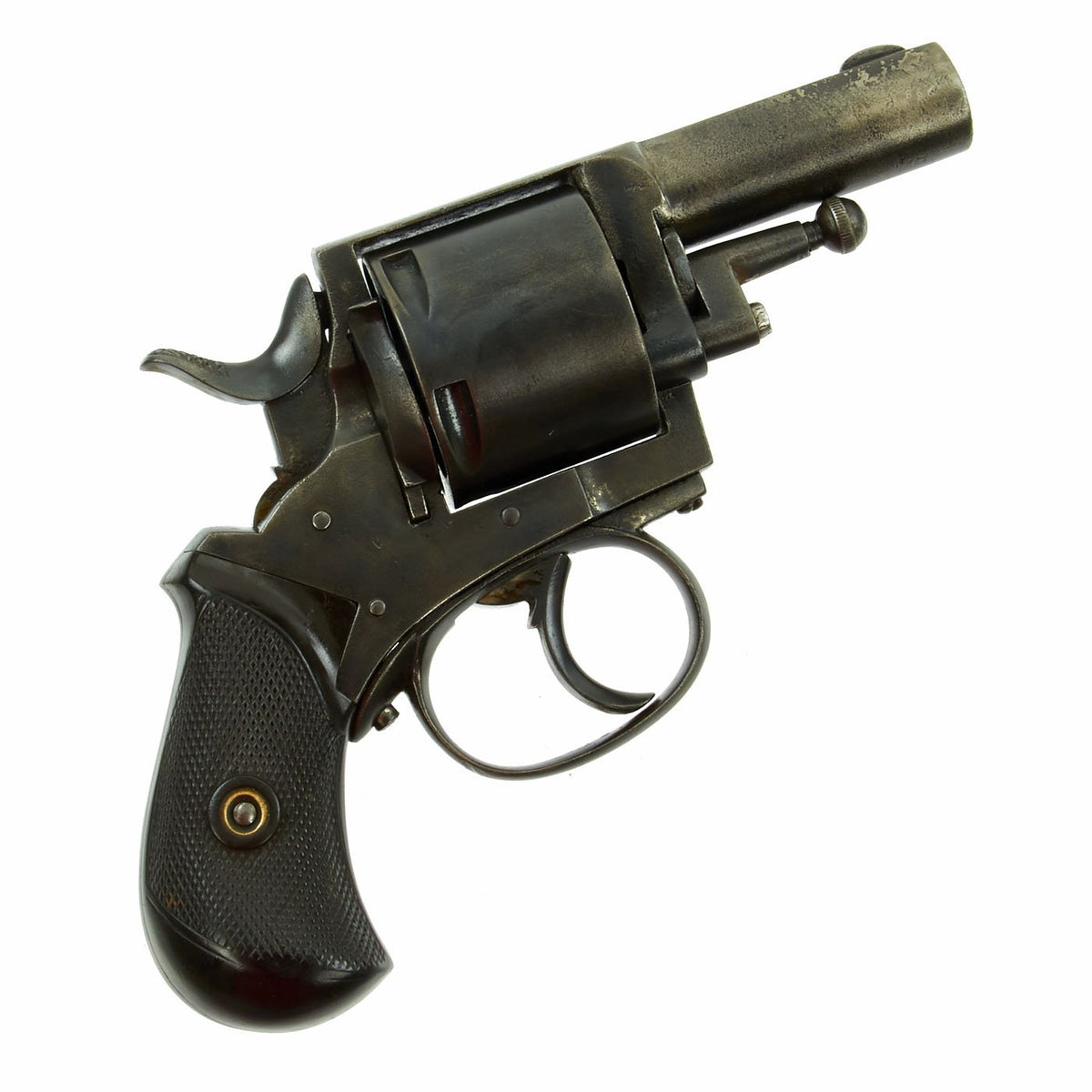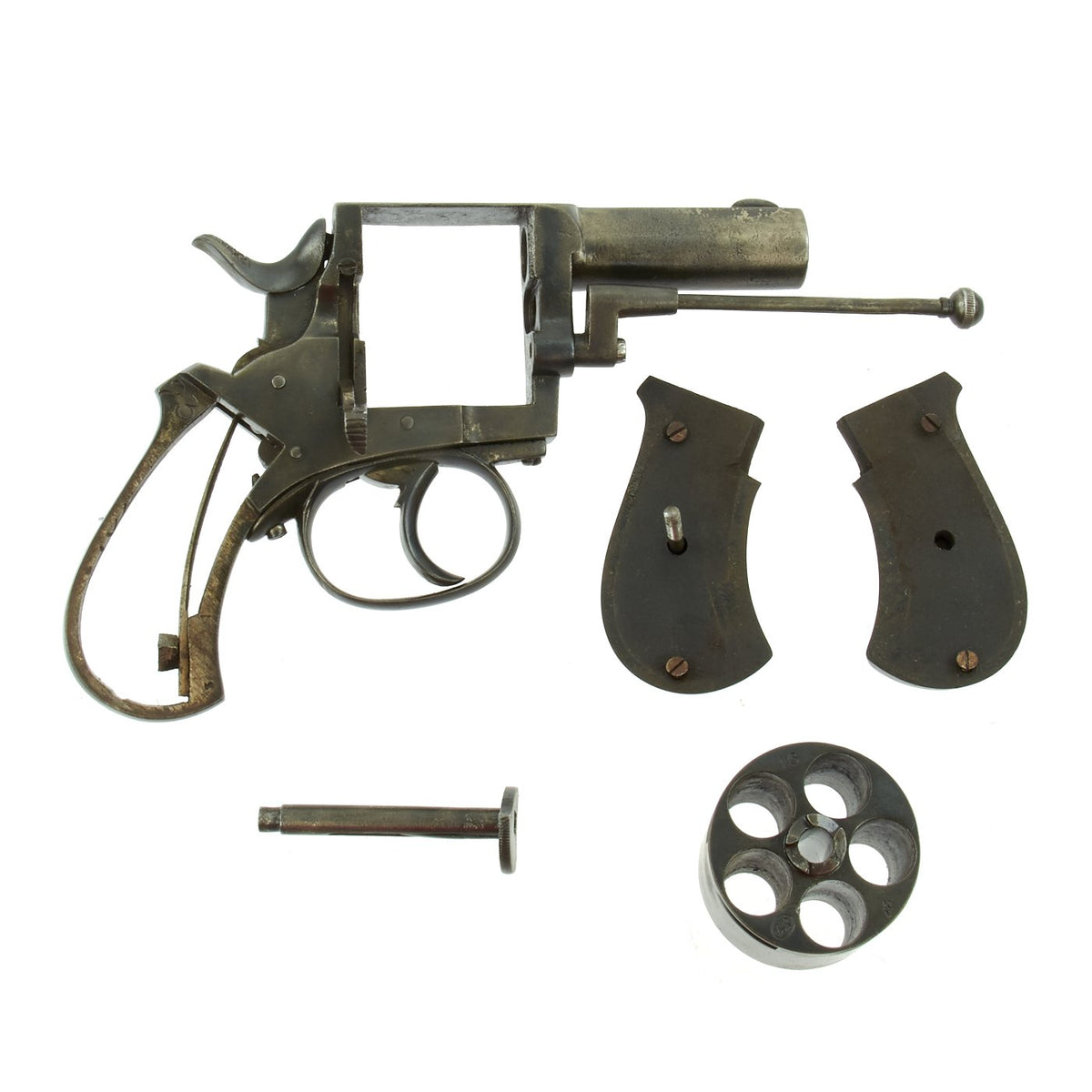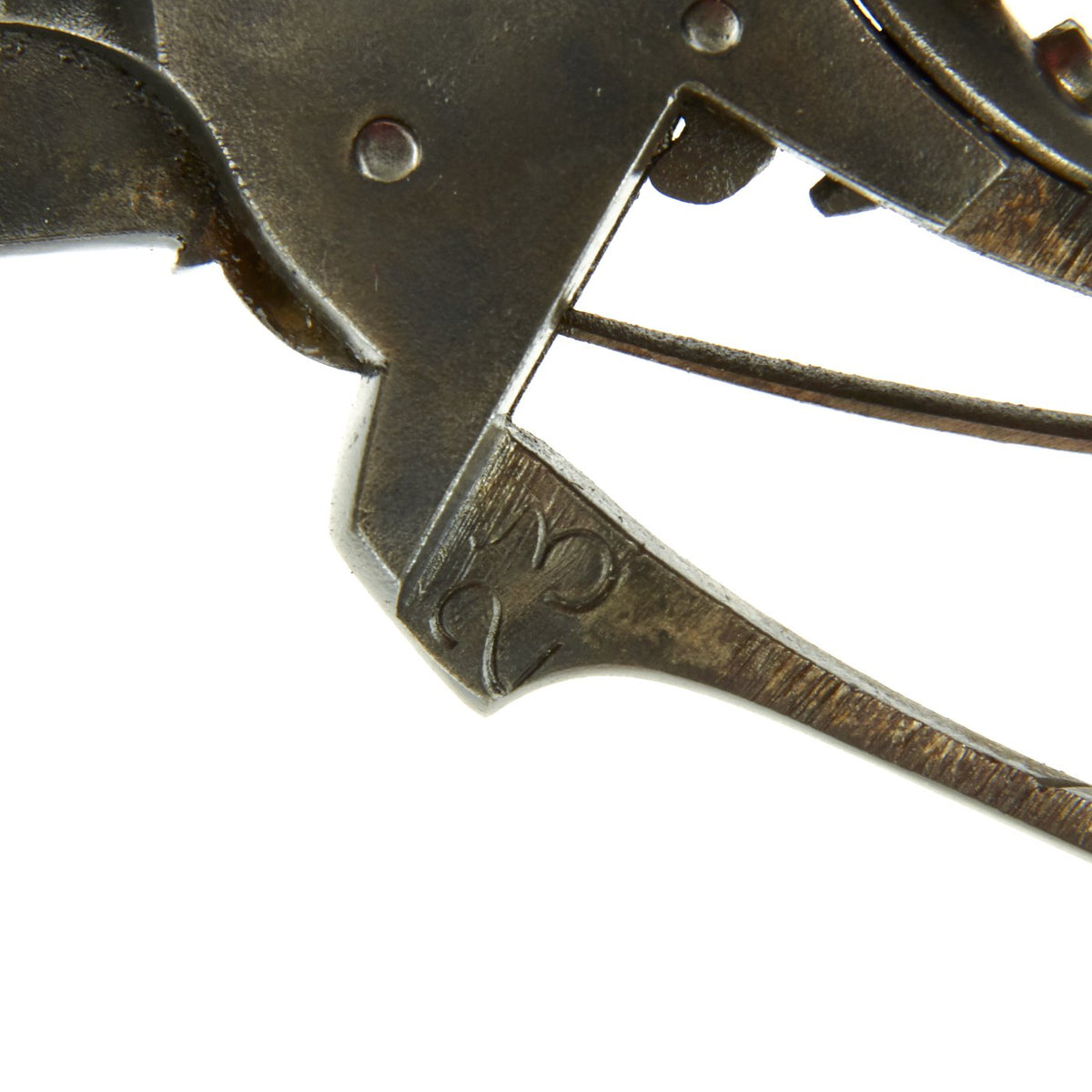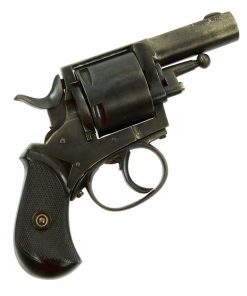Original British Victorian Era Belgian-made “British Bulldog” Revolver in .450 – Serial X 1013 Original Items
$ 495,00 $ 148,50
Original Item: Only one Available. This takes us straight back to “Jack the Ripper” and “Sherlock Holmes”: the closing years of Queen Victoria’s reign, with London’s fogged in streets rewound in time to the Policing of a bygone age.
These were hugely powerful often in .450 caliber and very snub nosed always associated with crime and punishment. A 2″ barrel , a FIVE shot cylinder and Bakelite Bird’s Head Grips only measuring 6″ in overall length but still like carrying a thunderbolt in your fist. Blue/Black finish overall in really crisp condition, especially the checkered grip panels.
The top strap over the cylinder is stamped BRITISH / BULLDOG, with the frame marked with serial number X 1013. The Cylinder and frame bear Belgian Proof marks, including E / LG / * in an oval, indicating production in the city of Liège for the British Market. The city was a powerhouse of arms production, taking in many government contracts, as well as contracts to private arms companies. The frame by the barrel is marked 450, indicating chambering in the very large .450 Adams / .450 Boxer Mk I cartridge. It was probably also designed to accommodate other similar black powder cartridges.
There are various assembly numbers on the frame and under the grip, as pictured. Condition is very good, with some wear. Barrel rifling is strong, and the revolver has a functional ejector rod and loading gate.
The revolver features double and single action, though the trigger return spring is slightly weak and could use an adjustment. A great display item from a bygone era!
Specifications:
Year of Manufacture: 1880s
Caliber: .450 Adams / .450 Boxer Mk I
Ammunition Type: Centerfire Cartridge
Overall Length: 6 inches
Barrel Length: 2 1/4 inches
Action: External Hammer Double/Single Action
Feed System: 5 Shot Revolver
Lineage
The pocket revolver known primarily as the “British Bull Dog” was first produced by P. Webley & Sons of Birmingham, England, in 1872. Its appeal was so great that the “British” Bulldog was adopted and copied by gun manufacturers in Belgium, Spain, France and the U.S. Though American-made Bulldogs came from the armorers Iver Johnson, Harrington & Richardson, Forehand & Wadsworth, and several other makers who quickly went in and out of business, the Webley versions are rightly considered the real McCoy.
Though the revolver remained in production until the WWI-era, the hay day of the Bulldog was in the 1870s to 1880s, a time when it was known its affordability and reliability, consequently making it one of the most popular pocket pistols in both Europe and America. Though Colt is the brand we all know and love, and their single actions are thought to have fit the hip of near every cowboy, ranch-hand and gunslinger, Colt’s single-actions sold for three to four times the cost of the British Bulldogs. The inexpensive, yet solidly made little dogs – many of which survive as shooters today – were available to everyman.
Build
Though this little gun has had as many variations and names as it had makers, the general features are quite simple: a 2.5-inch barrel, five-round capacity, double-action trigger, and an overall true small-frame pocket pistol.
Bulldogs are quickly recognizable by the bird’s head grips, generally made of either walnut or pearl. However, there are many fine examples with sweet ivory grips and delicate engraving. Most had a blued finish, but some nickeled models have survived as well. The revolver is generally dressed with simple fixed sights, a large looping trigger guard, curvaceous hammer spur and weigh in around 20 ounces.
Many European Bulldogs were chambered for .44 Short, .442 Webley, .455 Webley and .450 Adams, but there are several smaller variations of Webleys chambered in .320 and .380 calibers, though they were produced much later and were never labeled as Bulldogs.
Both the American and Belgian Bulldogs, which seem to be the most prevalent on the market these days, were readily available in smaller calibers. Perhaps the most common American clones housed .44 Webley and .38 caliber chamberings.
Famous ties
The Bulldog revolver has connections both famous and infamous in American history, as detailed George Layman’s book “The British Bulldog Revolver: The Forgotten Gun that Really Won the West!“
Probably the most infamous connection places it in the hands of Charles Guiteau, the man who shot President James Garfield in 1881. Though the wounded President lived for several months under the rudimentary medical care of the time, he succumbed to the pair of bullet wounds almost three-months later.
As the story goes, Guiteau was reportedly furious that Garfield overlooked him for appointment to a federal post and vowed to take vengeance on the President – and to do so with a good-looking gun, but one that could be had on a budget.
Guiteau is said to have used a Belgian-made British Bulldog in .44 caliber, but interestingly there is some debate over whether Guiteau got his wish of acquiring one with ivory grips. As rumor has it, he wanted his gun to look good when it eventually made its way to a museum, but the ivory upgrade cost several dollars more than the walnut model, which sold in the $8 to $12 range. The gun commonly shown as Guiteau’s model in period illustrations has walnut grips, but the actual gun is, in fact, long gone. Following Guiteau’s trial, the revolver was on loan to the Smithsonian, but, a short time later, the revolver disappeared and has not been found to this day. It is unclear whether the gun disappeared during its stay with the museum or sometime later.
Fast Shipping with Professional Packaging
Thanks to our longstanding association with UPS FedEx DHL, and other major international carriers, we are able to provide a range of shipping options. Our warehouse staff is expertly trained and will wrap your products according to our exact and precise specifications. Prior to shipping, your goods will be thoroughly examined and securely secured. We ship to thousands clients each day across multiple countries. This shows how we're dedicated to be the largest retailer on the internet. Warehouses and distribution centres can be located throughout Europe as well as the USA.
Note: Orders with more than one item will be assigned a processing date depending on the item.
Before shipping before shipping, we'll conduct a thorough inspection of the items you have ordered. Today, the majority of orders will be delivered within 48 hours. The delivery time will be between 3-7 days.
Returns
The stock is dynamic and we cannot completely manage it because multiple stakeholders are involved, including our factory and warehouse. So the actual stock may alter at any time. It's possible that you may not receive your order once the order has been made.
Our policy is valid for a period of 30 days. If you don't receive the product within 30 days, we are not able to issue a refund or an exchange.
You can only return an item if it is unused and in the same state as the day you received it. You must have the item in its original packaging.
Related products
Uncategorized
Uncategorized
Uncategorized
Uncategorized
Uncategorized
Uncategorized
Uncategorized
Uncategorized
Uncategorized
Uncategorized
Uncategorized
Australian WWII Owen MK1 Machine Carbine SMG Custom Fabricated Replica with Sling Original Items
Uncategorized
Uncategorized
Armored Burgonet Helmet & Polearm from Scottish Castle Leith Hall Circa 1700 Original Items
Uncategorized
Uncategorized
Uncategorized
Armoured Fighting Vehicles of the World: AFVs of World War One (Hardcover Book) New Made Items
Uncategorized












































































